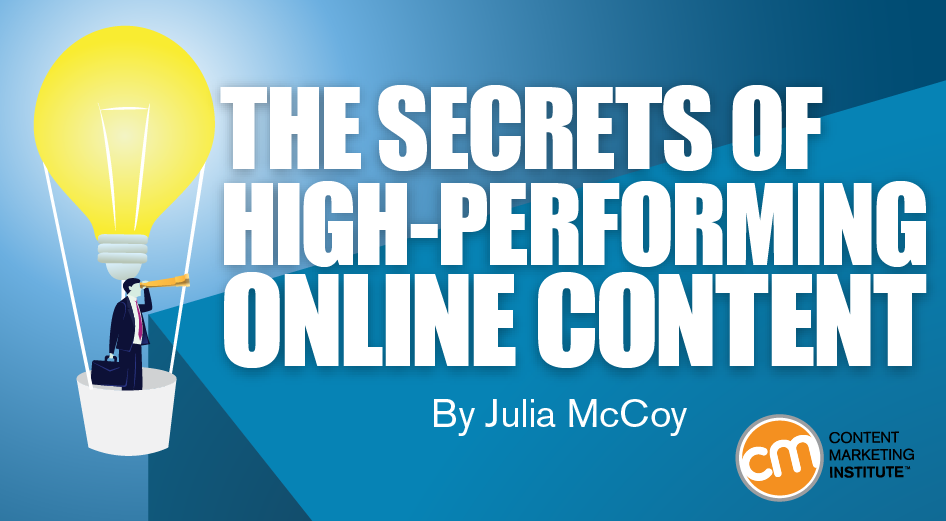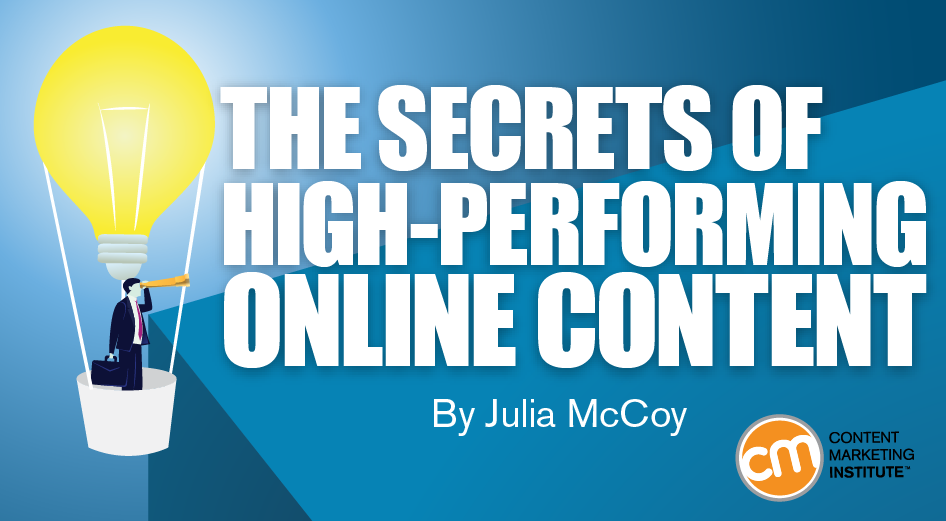Good content is one thing, but great online content is another. Use keywords based on target audience’s search intent If you want your content to perform better to hit your goals, you need to scoop up the right traffic. Make your headlines irresistible AND helpful High-performing content starts with a high-powered, irresistible headline that makes people want to read more. Does your headline accurately describe the content piece and let readers know what they’re in for if they keep reading? Here’s an example of a clickbait headline that’s misleading: Is this jaw-dropping? Clickbait headlines don’t perform well. How easy is it to follow you from point to point, line to line, and paragraph to paragraph? Create an utterly clickable CTA High-performing online content ultimately inspires action. Instead, it has many pieces that each contribute to its success – shares, conversions, sign-ups, or some other desirable reader action. You need each piece to inspire action and get results.

Good content is one thing, but great online content is another.
How do you define great content? Yes, it should be well-written, addictively readable, and hit home for its intended audience.
But it should also convert like crazy. After all, that’s the point of content creation for us, the marketers.
The good news is that content that is high-performing for us is useful for them, our readers. To reach this win-win, let’s look at what you can do to take your content from good to great, from “just OK” to high-powered, high-performing, and massively successful.
1. Use keywords based on target audience’s search intent
If you want your content to perform better to hit your goals, you need to scoop up the right traffic. Huge traffic numbers mean zilch if not one of those people takes action after clicking your link and consuming your content.
To funnel traffic that will translate into high performance and conversions, understand how your targets are searching and which keywords they’re using.
According to Practical Ecommerce, there are four types of search intent – navigational, informational, investigational, and transactional. CoSchedule defines three of them in this graphic:

Here are deeper explanations of the search-intent types:
- Informational intent – Searchers seek information. They want to find an answer to a question or a solution to a problem
Example: The bathroom sink is clogged. I perform a search to learn how to unclog a sink.
- Navigational intent – Searchers seek a specific company or website. They don’t necessarily want to buy any of their products. They want help navigating to the site.
Example: Uncertain of my local bookstore URL, I search the name of the store and visit the site to find out the store hours.
- Investigational intent – Searches with investigational intent hover between being informational and transactional in nature. People seek information to research future purchases and services they may want to buy, or companies they may want to buy from some day.
Example: I need a new pair of running shoes and want the best deal. I search types and brands to comparison shop and find the highest quality pair for the lowest price.
- Transactional intent – Searchers are ready to buy. They search with keywords that are long-tail, specific, and intentional.
Example: I know the brand, color, and size of running shoes I need. I want to buy them and have them arrive by next week. I search for “Nike women’s Free RN Flyknit running shoes blue size 8” and find the best price and delivery time – and purchase the shoes.

Target the keywords that hone in on the users’ search intent based on the action you want them to take. For example, if your goal is email list conversions, you might focus on informational intent searchers because they may discover you as a trusted source in your topic area. You might target keywords that begin with “how to” and ones that ask questions.
Look at how This Old House targets users with informational search intent and encourages them to connect with home improvement professionals in their area:

Bottom line: Help your content perform better and make sure you target the right keywords and search intent to achieve your goals.
2. Make your headlines irresistible AND helpful
High-performing content starts with a high-powered, irresistible headline that makes people want to read more.
You may have read about formulas and tools to help you craft headlines proven to perform better. But what about your headline’s usefulness factor?
Does your headline accurately describe the content piece and let readers know what they’re in for if they keep reading? Or does your headline use sneaky hyperbole and clickbait tactics to mislead readers?
Does your headline set up realistic expectations for the content? Or does it ultimately let your audience down?
Your content should build trust with the reader, but you can’t do that if you start with a headline that stretches the truth or neglects important information.
Here’s an example of a clickbait headline that’s misleading:

Is this jaw-dropping? No. Is the headline extremely misleading? Yes. The article reveals the kids are jumping into a swimming pool.
Here’s the interesting thing. Clickbait headlines don’t perform well. (Maybe this means people are catching on to the sneaky ways.) In a 2015 study,…

COMMENTS